Duke University
Duke University is a private research university in Durham, North Carolina. Founded by Methodists and Quakers in the present-day town of Trinity in 1838, the school moved to Durham in 1892.[14] In 1924, tobacco and electric power industrialist James Buchanan Duke established The Duke Endowment and the institution changed its name to honor his deceased father, Washington Duke.
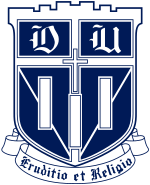 | |
| Latin: Universitas Dukiana[1] | |
Former names |
|
|---|---|
| Motto | Eruditio et Religio (Latin)[1] |
Motto in English | Knowledge and Faith[2] |
| Type | Private and nonsectarian |
| Established | 1838 |
Religious affiliation | United Methodist Church[3][4][5][6] |
Academic affiliations | |
| Endowment | $8.61 billion (2019)[7] (The university is also the primary beneficiary (32%) of the independent $3.69 billion Duke Endowment)[8] |
| Budget | $2.8 billion (FY 2020)[9] |
| President | Vincent Price[10] |
Academic staff | 3,774 (Fall 2018)[11] |
Administrative staff |
|
| Students | 15,892 (Fall 2018)[11] |
| Undergraduates | 6,994 (Fall 2018)[11] |
| Postgraduates | 8,898 (Fall 2018)[11] |
| Location | , , United States 36°0′4″N 78°56′20″W |
| Campus | Suburban/Urban[11] 8,693 acres (35.2 km2) |
| Colors | Duke blue, white[12][13] |
| Nickname | Blue Devils |
Sporting affiliations | NCAA Division I FBS – ACC |
| Website | www |
 | |
Duke's campus spans over 8,600 acres (3,500 hectares) on three contiguous sub-campuses in Durham as well as a marine lab in Beaufort. The West Campus—designed largely by architect Julian Abele—incorporates Gothic architecture with the 210-foot (64-meter) Duke Chapel at the campus' center and highest point of elevation, is adjacent to the Medical Center. East Campus, 1.5 miles (2.4 kilometers) away, home to all first-years, contains Georgian-style architecture. The university administers two concurrent schools in Asia, Duke-NUS Medical School in Singapore (established in 2005) and Duke Kunshan University in Kunshan, China (established in 2013).[15]
Several faculty members, affiliates and alumni have been awarded the Nobel Prize in recent years. Notable awardees since 2012 include Robert Lefkowitz, Brian Kobilka, Gregg L. Semenza, Paul Modrich, William Kaelin, and George Smith. In 2019, Clarivate Analytics named 54 members of Duke's faculty to its list of "Highly Cited Researchers". That number places Duke 8th among the world's universities.[16] As of 2019, 15 Nobel laureates and 3 Turing Award winners have been affiliated with the university. Duke alumni also include 50 Rhodes Scholars and 25 Churchill Scholars.[17][18] The university has produced the third highest number of Churchill Scholars of any university (behind Princeton and Harvard) and the fifth-highest number of Rhodes, Marshall, Truman, Goldwater, and Udall Scholars of any American university between 1986 and 2015.[19] Duke is the alma mater of one president of the United States (Richard Nixon) and 14 living billionaires.[20]
Duke is the second-largest private employer in North Carolina, with more than 39,000 employees.[21][22] The university has been ranked as an excellent employer by several publications.[23][24]
History
Beginnings
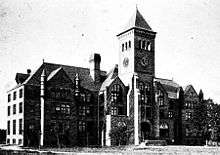
Duke first opened in 1838 as Brown's Schoolhouse, a private subscription school founded in Randolph County in the present-day town of Trinity.[25] Organized by the Union Institute Society, a group of Methodists and Quakers, Brown's Schoolhouse became the Union Institute Academy in 1841 when North Carolina issued a charter. The academy was renamed Normal College in 1851 and then Trinity College in 1859 because of support from the Methodist Church.[25] In 1892, Trinity College moved to Durham, largely due to generosity from Julian S. Carr and Washington Duke, powerful and respected Methodists who had grown wealthy through the tobacco and electrical industries.[14] Carr donated land in 1892 for the original Durham campus, which is now known as East Campus. At the same time, Washington Duke gave the school $85,000 for an initial endowment and construction costs—later augmenting his generosity with three separate $100,000 contributions in 1896, 1899, and 1900—with the stipulation that the college "open its doors to women, placing them on an equal footing with men."[26]
In 1924 Washington Duke's son, James B. Duke, established The Duke Endowment with a $40 million trust fund. Income from the fund was to be distributed to hospitals, orphanages, the Methodist Church, and four colleges (including Trinity College). William Preston Few, the president of Trinity at the time, insisted that the institution be renamed Duke University to honor the family's generosity and to distinguish it from the myriad other colleges and universities carrying the "Trinity" name. At first, James B. Duke thought the name change would come off as self-serving, but eventually, he accepted Few's proposal as a memorial to his father.[14] Money from the endowment allowed the University to grow quickly. Duke's original campus, East Campus, was rebuilt from 1925 to 1927 with Georgian-style buildings. By 1930, the majority of the Collegiate Gothic-style buildings on the campus one mile (1.6 km) west were completed, and construction on West Campus culminated with the completion of Duke Chapel in 1935.[27]
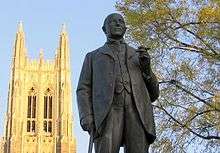
In 1878, Trinity (in Randolph County) awarded A.B. degrees to three sisters—Mary, Persis, and Theresa Giles—who had studied both with private tutors and in classes with men. With the relocation of the college in 1892, the Board of Trustees voted to again allow women to be formally admitted to classes as day students. At the time of Washington Duke's donation in 1896, which carried the requirement that women be placed "on an equal footing with men" at the college, four women were enrolled; three of the four were faculty members' children. In 1903 Washington Duke wrote to the Board of Trustees withdrawing the provision, noting that it had been the only limitation he had ever put on a donation to the college. A woman's residential dormitory was built in 1897 and named the Mary Duke Building, after Washington Duke's daughter. By 1904, fifty-four women were enrolled in the college. In 1930, the Woman's College was established as a coordinate to the men's undergraduate college, which had been established and named Trinity College in 1924.[28]
Expansion and growth
Engineering, which had been taught at Duke since 1903, became a separate school in 1939. In athletics, Duke hosted and competed in the only Rose Bowl ever played outside California in Wallace Wade Stadium in 1942.[25] During World War II, Duke was one of 131 colleges and universities nationally that took part in the V-12 Navy College Training Program which offered students a path to a navy commission.[29] In 1963 the Board of Trustees officially desegregated the undergraduate college.[30]
Duke enrolled its first black graduate students in 1961.[31] The school did not admit Black undergraduates until September 1963. The teaching staff remained all-White until 1966.[32]
Increased activism on campus during the 1960s prompted Martin Luther King Jr. to speak at the University in November 1964 on the progress of the Civil Rights Movement. Following Douglas Knight's resignation from the office of university president, Terry Sanford, the former governor of North Carolina, was elected president of the university in 1969, propelling The Fuqua School of Business' opening, the William R. Perkins library completion, and the founding of the Institute of Policy Sciences and Public Affairs (now the Sanford School of Public Policy). The separate Woman's College merged back with Trinity as the liberal arts college for both men and women in 1972.
Beginning in the 1970s, Duke administrators began a long-term effort to strengthen Duke's reputation both nationally and internationally. Interdisciplinary work was emphasized, as was recruiting minority faculty and students. During this time it also became the birthplace of the first Physician Assistant degree program in the United States.[33][34][35] Duke University Hospital was finished in 1980 and the student union building was fully constructed two years later. In 1986 the men's soccer team captured Duke's first National Collegiate Athletic Association (NCAA) championship, and the men's basketball team followed shortly thereafter with championships in 1991 and 1992, then again in 2001, 2010, and 2015.
Duke's growth and academic focus have contributed to continuing the university's reputation as an academic and research powerhouse.[36] Duke Forward, a seven-year fundraising campaign, raised $3.85 billion[37] through June 30, 2017. The record giving by more than 315,000 donors and foundations will enrich the student experience in and out of the classroom, invest in faculty and support research and initiatives.
Recent history
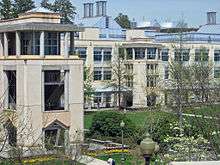
In 2014, Duke removed the name of white-supremacist leader Charles B. Aycock from an undergraduate dormatory.[39] It is now known as the East Residence Hall.
On August 19, 2017, following the violent clashes at the Unite the Right rally in Charlottesville, Virginia, the statue of Confederate Gen. Robert E. Lee was removed from the entrance to the Duke University Chapel, after having been vandalized by protesters.[40][41][42][43][44]
Controversies
In 2006, three men's lacrosse team members were falsely accused of rape,[45][46] which garnered significant media attention.[47] On April 11, 2007, North Carolina Attorney General Roy Cooper dropped all charges and declared the three players innocent. Cooper stated that the charged players were victims of a "tragic rush to accuse."[48][49] The District Attorney, Michael Nifong, was subsequently disbarred.[50]
In 2019, Duke paid $112.5 Million to settle False Claims Act allegations related to scientific research misconduct. A researcher at the school was falsifying or fabricating research data, in order to win grants for financial gain. The researcher was arrested in 2013 on charges of embezzling funds from the university. The scheme was exposed by the allegations made through a lawsuit, filed by a whistleblower, who had worked as a Duke employee, and discovered the false data.[51][52]
In response to the misconduct settlement, Duke established an advisory panel of academics from Caltech, Stanford and Rockefeller University. Based on the recommendations of this panel, the Duke Office of Scientific Integrity (DOSI) was established under the leadership of Lawrence Carin, an engineering professor who is one of the world's leading experts on machine learning and artificial intelligence [53] The establishment of this office brings Duke's research practices in line with those at peer institutions like Johns Hopkins University.[54]
Campus
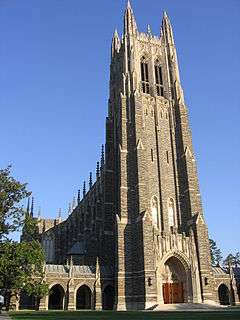
Duke University currently owns 256 buildings on 8,693 acres (35.18 km2) of land, which includes the 7,044 acres (28.51 km2) Duke Forest.[11] The campus is divided into four main areas: West, East, and Central campuses and the Medical Center, which are all connected via a free bus service. On the Atlantic coast in Beaufort, Duke owns 15 acres (61,000 m2) as part of its marine lab. One of the major public attractions on the main campus is the 54-acre (220,000 m2) Sarah P. Duke Gardens, established in the 1930s.[11]
Duke students often refer to the campus as "the Gothic Wonderland", a nickname referring to the Collegiate Gothic architecture of West Campus.[55][56][57] Much of the campus was designed by Julian Abele, one of the first prominent African-American architects and the chief designer in the offices of architect Horace Trumbauer.[58] The residential quadrangles are of an early and somewhat unadorned design, while the buildings in the academic quadrangles show influences of the more elaborate late French and Italian styles. The freshmen campus, known as East Campus, is composed of buildings in the Georgian architecture style. In 2011, Travel+Leisure listed Duke among the most beautiful college campuses in the United States.[59]
The stone used for West Campus has seven primary colors and seventeen shades of color.[60] The university supervisor of planning and construction wrote that the stone has "an older, more attractive antique effect" and a "warmer and softer coloring than the Princeton stone" that gave the university an "artistic look."[60] James B. Duke initially suggested the use of stone from a quarry in Princeton, New Jersey, but later amended the plans to purchase a local quarry in Hillsborough to reduce costs.[60] Duke Chapel stands at the center of West Campus on the highest ridge. Constructed from 1930 to 1935, the chapel seats 1,600 people and, at 210 feet (64 m) is one of the tallest buildings in Durham County.[61]
A number of construction projects were in progress during 2015, including renovations to Duke Chapel, Wallace Wade Stadium (football) and Cameron Indoor Stadium (basketball).[62]
In early 2014, the Nicholas School of the Environment opened a new home, Environmental Hall,[63] a five-story, glass-and-concrete building that incorporates the highest sustainable features and technologies, and meets or exceeds the criteria for LEED platinum certification. The School of Nursing in April 2014 opened a new 45,000-square-foot addition to the Christine Siegler Pearson Building.[64] In summer 2014, a number of construction projects were completed.[65] The project is part of the final phase of renovations to Duke's West Campus libraries that have transformed one of the university's oldest and most recognizable buildings into a state-of-the-art research facility. The David M. Rubenstein Rare Book and Manuscript Library reopened in August 2015 after about $60 million in renovations to the sections of the building built in 1928 and 1948. The renovations include more space, technology upgrades and new exhibits.
In 2013, construction projects included transforming buildings like Gross Hall and Baldwin Auditorium, plus new construction such as the Events Pavilion. About 125,000 square feet was updated at Gross Hall, including new lighting and windows and a skylight.[66] Baldwin's upgrades include a larger stage, more efficient air conditioning for performers and audience and enhanced acoustics that will allow for the space to be "tuned" to each individual performance.[67] The 25,000-square-foot Events Pavilion opened to students in 2013 and serves as temporary dining space while the West Campus Union undergoes major renovations, expected to be completed in the spring of 2016. From February 2001 to November 2005, Duke spent $835 million on 34 major construction projects as part of a five-year strategic plan, "Building on Excellence."[68] Completed projects since 2002 include major additions to the business, law, nursing, and divinity schools, a new library, the Nasher Museum of Art, a football training facility, two residential buildings, an engineering complex, a public policy building, an eye institute, two genetic research buildings, a student plaza, the French Family Science Center, and two new medical-research buildings.[69]
In early 2012, the Duke Cancer Center opened next to Duke Hospital in Durham.[70] The patient care facility consolidates nearly all of Duke's outpatient clinical care services.
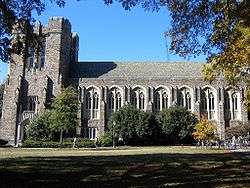
West, East, and Central Campuses
See main article, Duke University West Campus
West Campus, considered the main campus of the University, houses the sophomores and juniors, along with some seniors.[71] Most of the academic and administrative centers are located there. Main West Campus, with Duke Chapel at its center, contains the majority of residential quads to the south, while the main academic quad, library, and Medical Center are to the north. The campus, spanning 720 acres (2.9 km2), includes Science Drive, which is the location of science and engineering buildings. The residential quads on West Campus are Craven Quad, Crowell Quad, Edens Quad, Few Quad, Keohane Quad, Kilgo Quad, and Wannamaker Quad.[72] Most of the campus eateries and sports facilities—including the historic basketball stadium, Cameron Indoor Stadium—are on West Campus.[73]

East Campus, the original location of Duke after it moved to Durham,[74] functions as a first-year campus, housing the university's freshmen dormitories as well as the home of several academic departments. Since the 1995–96 academic year, all freshmen—and only freshmen, except for upperclassmen serving as Resident Assistants—have lived on East Campus, an effort to build class unity. The campus encompasses 172 acres (700,000 m2) and is 1.5 miles (2.4 km) from West Campus.[11] African and African American Studies, Art History, History, Cultural Anthropology, Literature, Music, Philosophy, and Women's Studies are housed on East.[74] Programs such as dance, drama, education, film, and the University Writing Program reside on East. The self-sufficient East Campus contains the freshmen residence halls, a dining hall, coffee shop, post office, Lilly Library, Baldwin Auditorium, a theater, Brodie Gym, tennis courts, several disc golf baskets, and a walking track as well as several academic buildings.[74] The East Campus dorms are Alspaugh, Basset, Bell Tower, Blackwell, Brown, East House (formerly known as Aycock), Epworth, Gilbert-Addoms, Giles, Jarvis, Pegram, Randolph, Southgate, Trinity, and Wilson.[75] Separated from downtown by a short walk, the area was the site of the Women's College from 1930 to 1972.[74]

Central Campus, consisting of 122 acres (0.49 km2) between East and West campuses, housed around 1,000 sophomores, juniors, and seniors, as well as around 200 professional students in double or quadruple apartments.[76] However, the housing of undergraduates on Central Campus ended after the 2018–2019 school year.[77] Central Campus is home to the Nasher Museum of Art, the Freeman Center for Jewish Life, the Center for Muslim Life, the Duke Police Department, the Duke Office of Disability Management, a Ronald McDonald House, and administrative departments such as Duke Residence Life and Housing Services. Central Campus has several recreation and social facilities such as basketball courts, a sand volleyball court, a turf field, barbecue grills and picnic shelters, a general gathering building called "Devil's Den", a restaurant known as "Devil's Bistro", a convenience store called Uncle Harry's, and the Mill Village. The Mill Village consists of a gym and group study rooms.[76][78]
Other key places
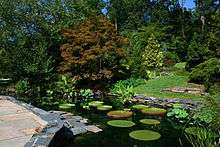
Duke Forest, established in 1931, consists of 7,044 acres (28.51 km2) in six divisions, just west of West Campus.[11] The largest private research forest in North Carolina and one of the largest in the nation,[79] the Duke Forest demonstrates a variety of forest stand types and silvicultural treatments. Duke Forest is used extensively for research and includes the Aquatic Research Facility, Forest Carbon Transfer and Storage (FACTS-I) research facility, two permanent towers suitable for micrometeorological studies, and other areas designated for animal behavior and ecosystem study.[80] More than 30 miles (48 km) of trails are open to the public for hiking, cycling, and horseback riding.[81]
The Duke Lemur Center, located inside the Duke Forest, is the world's largest sanctuary for rare and endangered strepsirrhine primates.[82] Founded in 1966, the Duke Lemur Center spans 85 acres (34 ha) and contains nearly 300 animals of 25 different species of lemurs, galagos and lorises.[83]
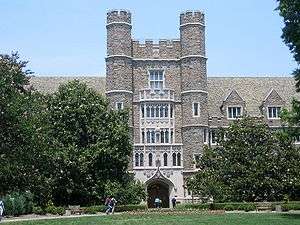
The Sarah P. Duke Gardens, established in the early 1930s, is situated between West Campus and Central Campus. The gardens occupy 55 acres (22 ha), divided into four major sections:[84] the original Terraces and their surroundings; the H.L. Blomquist Garden of Native Plants, devoted to flora of the Southeastern United States; the W.L. Culberson Asiatic Arboretum, housing plants of Eastern Asia, as well as disjunct species found in Eastern Asia and Eastern North America; and the Doris Duke Center Gardens. There are five miles (8.0 km) of allées and paths throughout the gardens.[84]
Duke University Medical Center, bordering Duke's West Campus northern boundary, combines one of the top-rated hospitals[85] and one of the top-ranked medical schools[86] in the U.S. Founded in 1930, the Medical Center occupies 8 million square feet (700,000 m²) in 99 buildings on 210 acres (85 ha).[87]
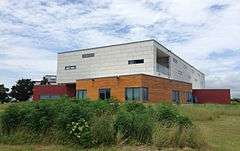
Duke University Marine Laboratory, located in the town of Beaufort, North Carolina, is also technically part of Duke's campus. The marine lab is situated on Pivers Island on the Outer Banks of North Carolina, 150 yards (140 m) across the channel from Beaufort. Duke's interest in the area began in the early 1930s and the first buildings were erected in 1938.[88] The resident faculty represent the disciplines of oceanography, marine biology, marine biomedicine, marine biotechnology, and coastal marine policy and management. The Marine Laboratory is a member of the National Association of Marine Laboratories.[88] In May 2014, the newly built Orrin H. Pilkey Marine Research Laboratory was dedicated.[89]
Singapore and China
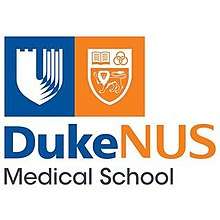

In April 2005, Duke and the National University of Singapore signed a formal agreement under which the two institutions would partner to establish the Duke-NUS Medical School in Singapore. [90][91]Duke-NUS is intended to complement the National University of Singapore's existing undergraduate medical school, and had its first entering class in 2007.[92] The curriculum is based on that of the Duke University School of Medicine. 60% of matriculates are from Singapore and 40% are from over 20 countries. The school is part of the National University of Singapore system, but distinct in that it is overseen by a Governing Board, including a Duke representative who has veto power over any academic decision made by the Board.[93][91]
In 2013,[94]Duke Kunshan University (abbreviated "DKU"), a partnership between Duke University, Wuhan University, and the city of Kunshan, was established in Kunshan, China. The university runs graduate programs and an undergraduate liberal arts college. Students are awarded degrees from both Duke Kunshan University and Duke University upon graduation and become members of Duke and DKU's alumni organizations.[95] DKU conducted research projects on climate change, health-care policy and tuberculosis prevention and control.[96]
Administration and organization
| School founding | |
|---|---|
| School | Year founded |
| Trinity College of Arts and Sciences | 1838 |
| Duke University School of Law | 1868 |
| Graduate School of Duke University | 1926 |
| Duke Divinity School | 1926 |
| Duke University School of Medicine | 1930 |
| Duke University School of Nursing | 1931 |
| Nicholas School of the Environment | 1938 |
| Pratt School of Engineering | 1939 |
| Fuqua School of Business | 1969 |
| Sanford School of Public Policy | 1971 |
| Duke-NUS Medical School | 2007 |
| Duke Kunshan University | 2013 |
Duke University has 12 schools and institutes, three of which host undergraduate programs: Trinity College of Arts and Sciences, Pratt School of Engineering, and Duke Kunshan University.[97][98]
The university has "historical, formal, ongoing, and symbolic ties" with the United Methodist Church, but is a nonsectarian and independent institution.[99][5][6][4]
Duke's endowment had a market value of $8.6 billion in the fiscal year that ended June 30, 2019.[7] The University's special academic facilities include an art museum, several language labs, the Duke Forest, the Duke Herbarium, a lemur center, a phytotron, a free electron laser, a nuclear magnetic resonance machine, a nuclear lab, and a marine lab. Duke is a leading participant in the National Lambda Rail Network and runs a program for gifted children known as the Talent Identification Program.[100][101]
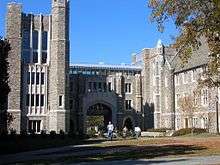
Academics
Admissions
| Admissions statistics (2020)[102] | |
|---|---|
| Admit rate | 7.7% |
Admission to Duke is defined by U.S. News & World Report as "most selective." Duke received nearly 39,800 applications for the Class of 2024, with an overall acceptance rate of 7.7%.[102] The yield rate (the percentage of accepted students who choose to attend) for the Class of 2023 was 54%.[103] The Class of 2022 had an ACT range of 33-35 and an SAT range of 1490–1560.[104] (Test score ranges account for the 25th-75th percentile of accepted students.)
From 2001 to 2011, Duke has had the sixth highest number of Fulbright, Rhodes, Truman, and Goldwater scholarships in the nation among private universities.[105][106][107][108] The University practices need-blind admissions and meets 100% of admitted students' demonstrated need. About 50 percent of all Duke students receive some form of financial aid, which includes need-based aid, athletic aid, and merit aid. The average need-based grant for the 2018–19 academic year was $53,255.[11] In 2020, a study by the Chronicle of Higher Education ranked Duke first on its list of "Colleges That Are the Most Generous to the Financially Neediest Students".[109]
Roughly 60 merit-based full tuition scholarships are offered, including the Angier B. Duke Memorial Scholarship awarded for academic excellence, the Benjamin N. Duke Scholarship awarded for community service, and the Robertson Scholars Leadership Program, a joint scholarship and leadership development program granting full student privileges at both Duke and UNC-Chapel Hill. Other scholarships are geared toward students in North Carolina, African-American students, children of alumni, and high-achieving students requiring financial aid.[110]
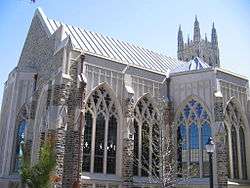
Graduate profile
In 2009, the School of Medicine received 5,166 applications[111] and accepted approximately 4% of them,[112] while the average GPA and MCAT scores for accepted students from 2002 through 2009 were 3.74 and 34, respectively.[113][114] The School of Law accepted approximately 13% of its applicants for the Class of 2014, while enrolling students had a median GPA of 3.75 and median LSAT of 170.[115]
The University's graduate and professional schools include the Graduate School, the Pratt School of Engineering, the Nicholas School of the Environment, the School of Medicine, the Duke-NUS Medical School, the School of Nursing, the Fuqua School of Business, the School of Law, the Divinity School, and the Sanford School of Public Policy.[116]
Undergraduate curriculum
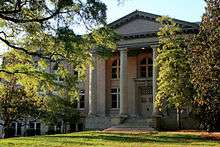
Duke offers 46 arts and sciences majors, four engineering majors, 52 minors (including two in engineering) and Program II, which allows students to design their own interdisciplinary major in arts & sciences, and IDEAS, which allows students to design their own engineering major.[117] Twenty-four certificate programs also are available.[117] Students pursue a major and can pursue a combination of a total of up to three, including minors, certificates, and/or a second major. Eighty-five percent of undergraduates enroll in the Trinity College of Arts and Sciences. The balance enroll in Duke's Pratt School of Engineering.[118]
Trinity College of Arts and Sciences
Trinity's curriculum operates under the revised version of "Curriculum 2000."[119] It ensures that students are exposed to a variety of 5 "areas of knowledge" and 6 "modes of inquiry." List of Duke Curricular Requirements, Retrieved April 25, 2019.</ref> The curriculum aims to help students develop critical faculties and judgment by learning how to access, synthesize, and communicate knowledge effectively. The intent is to assist students in acquiring perspective on current and historical events, conducting research and solving problems, and developing tenacity and a capacity for hard and sustained work.[119] Freshmen can elect to participate in the FOCUS Program, which allows students to engage in an interdisciplinary exploration of a specific topic in a small group setting in their first semesters.[120]
Pratt School of Engineering
The curriculum of Duke's Pratt School of Engineering, significantly transformed in recent years, immerses students in design, computing, research, and entrepreneurship — but still accommodates educational opportunities, including double majors, in a variety of disciplines from across Duke.[121] The school emphasizes undergraduate research opportunities with faculty. Research and design opportunities arise through a real-world design course for first-year students,[122] internships, independent study and research fellowships,[123] and through design-focused capstone courses. More than 60 percent of Duke Engineering undergraduates have an intensive research experience during their four years, and nearly a fifth publish or present a research paper off-campus. Nearly 54 percent of Duke Engineering undergraduates intern or study abroad. Eighty-five percent have jobs or job offers at the time of graduation.[124]
Libraries and museums
Duke Libraries includes the Perkins, Bostock, and Rubenstein Libraries on West Campus, the Lilly and Music Libraries on East Campus, the Pearse Memorial Library at the Duke Marine Lab, and the separately administered libraries serving the schools of business, divinity, law and medicine.
Duke's art collections are housed at the Nasher Museum of Art on Central Campus. The museum was designed by Rafael Viñoly and is named for Duke alumnus and art collector Raymond Nasher. The museum opened in 2005 at a cost of over $23 million and contains over 13,000 works of art, including works by William Cordova, Marlene Dumas, Olafur Eliasson, David Hammons, Barkley L. Hendricks, Christian Marclay, Kerry James Marshall, Alma Thomas, Hank Willis Thomas, Bob Thompson, Kara Walker, Andy Warhol, Carrie Mae Weems, Ai Weiwei, Fred Wilson, and Lynette Yiadom Boakye.[125]
Research
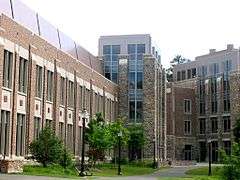
Duke's research expenditures in the 2018 fiscal year were $1.168 billion, the tenth largest in the U.S.[126] In fiscal year 2019 Duke received $571 million in funding from the National Institutes of Health.[127] Duke is classified among "R1: Doctoral Universities – Very high research activity".[128]
Throughout the school's history, Duke researchers have made breakthroughs, including the biomedical engineering department's development of the world's first real-time, three-dimensional ultrasound diagnostic system and the first engineered blood vessels and stents.[129] In 2015, Paul Modrich shared the Nobel Prize in Chemistry. In 2012, Robert Lefkowitz along with Brian Kobilka, who is also a former affiliate, shared the Nobel Prize in chemistry for their work on cell surface receptors.[130] Duke has pioneered studies involving nonlinear dynamics, chaos, and complex systems in physics.
In May 2006 Duke researchers mapped the final human chromosome, which made world news as the Human Genome Project was finally complete.[131] Reports of Duke researchers' involvement in new AIDS vaccine research surfaced in June 2006.[132] The biology department combines two historically strong programs in botany and zoology, while one of the divinity school's leading theologians is Stanley Hauerwas, whom Time named "America's Best Theologian" in 2001.[133] The graduate program in literature boasts several internationally renowned figures, including Fredric Jameson,[134] Michael Hardt,[135] and Rey Chow, while philosophers Robert Brandon and Lakatos Award-winner Alexander Rosenberg contribute to Duke's ranking as the nation's best program in philosophy of biology, according to the Philosophical Gourmet Report.[136]
The Faculty Scholarly Productivity Index ranked Duke's faculty first in the nation in the fields of Oncology and Cancer Biology, Biomedical Engineering and Applied Economics. The Public Policy, Statistics, Chemistry, Environmental Science, Medicine and Molecular Genetics departments (among others) all ranked in the top five. Several other departments including Electrical Engineering, Mechanical Engineering and Nursing ranked in the top ten.[137]
Reputation and rankings
|
|
| ||||||||||||||||||||||||||||||||||||||||||||||||||||||||||||||||||||||||||||||||||||||||||||||||||||||||||||||||||||||||||||||||||||||
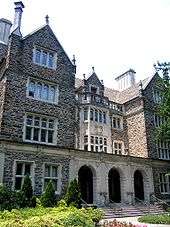
Undergraduate rankings
In the past thirty years, U.S. News & World Report has placed Duke as high as 3rd and as low as 10th.[149] Duke University is ranked in the top 10 in the following college ranking publications: Niche (6th),[150] U.S. News & World Report (10th), Washington Monthly (6th),[151] Kiplinger (8th),[152] The Wall Street Journal "Student Outcomes" (3rd), The Wall Street Journal (10th),[153] Forbes (9th), The Washington Post (7th),[154] CollegeFactual (3rd)[155] and Business Insider (8th).[156] In 2014, Duke was ranked 1st in the United States for majors in psychology,[157][158] and 10th overall for computer science and engineering.[159] In 2014 and 2018, Duke was ranked 1st in the United States for majors in economics.[160] In 2016, The Washington Post ranked Duke 7th overall based on the accumulated weighted average of the rankings from U.S. News & World Report, Washington Monthly, Wall Street Journal/Times Higher Education, Times Higher Education (global), Money and Forbes.[154]
In 2020, Duke was ranked 22nd in the world by U.S. News & World Report and 20th in the world by the Times Higher Education World University Rankings.[161][162] QS World University Rankings ranked Duke 25th the world for its 2020 rankings.[163] Duke was ranked 28th best globally by the Academic Ranking of World Universities (ARWU) in 2019, focusing on quality of scientific research and the number of Nobel Prizes.[164] The 2010 report by the Center for Measuring University Performance puts Duke at 6th in the nation.[36]
The 2012 Global Employability Ranking as published by The New York Times surveyed hundreds of chief executives and chairmen from around the world and asked them to select the best universities from which they recruited. Duke placed 26th in the world and 12th in the country.[165][166] Duke also ranked 42nd in the world and 12th in the country on Times Higher Education's global employability ranking in 2019.[167]
In 2018, Duke enrolled 106 National Merit Scholars, the 19th university in rank by number.[168] Duke ranks 5th among national universities to have produced Rhodes, Marshall, Truman, Goldwater, and Udall Scholars.[19] As of 2012, Duke graduates have received 25 Churchill Scholarships to the University of Cambridge. Only graduates of Princeton and Harvard have received more Churchill awards.[169] Kiplinger's 50 Best Values in Private Universities 2013–14 ranks Duke at 5th best overall after taking financial aid into consideration.[170]
In a 2016 study by Forbes, Duke ranked 11th among universities in the United States that have produced billionaires and 1st among universities in the South.[171] A survey by the Journal of Blacks in Higher Education in 2002 ranked Duke as the #1 university in the country in regard to the integration of African American students and faculty.[172] According to a poll of recruiters conducted by The Wall Street Journal, Duke ranks 2nd in terms of producing the best graduates who have received either a marketing or liberal arts degree. In a corporate study carried out by The New York Times, Duke's graduates were shown to be among the most valued in the world,[173] and Forbes magazine ranked Duke 7th in the world on its list of 'power factories' in 2012.[174] Duke was ranked 17th on Thomson Reuters' list of the world's most innovative universities in 2015. The ranking graded universities based on patent volume and research output among other factors.[175] In 2015, NPR ranked Duke first on its list of "schools that make financial sense".[176] Time magazine ranked Duke third on its list of the "Best 50 Colleges for African Americans". The ranking was based on representation, affordability and post-graduate earnings.[177] In 2016, Forbes ranked Duke sixth on its list of "Expensive Schools Worth Every Penny".[178]
Duke has also been recognized as the third-best university employer in the country, behind Stanford University and Harvard University.[179]
Graduate school rankings
Duke has been named one of the top universities for graduate outcomes several years in a row, having tied with Harvard University and Yale University.[180][181] In U.S. News & World Report's "America's Best Graduate Schools 2021", Duke's medical school ranked tied for 12th in research[182] and 26th in primary care.[183] The School of Law was ranked 12th in the 2021 rankings by the same publication,[184] with Duke's nursing school ranked 2nd[185] while the Sanford School of Public Policy ranked 5th in Public Policy Analysis for 2019.[186] Among business schools in the United States, the Fuqua School of Business is ranked tied for 10th overall by U.S. News & World Report for 2020, while BusinessWeek ranked its full-time MBA program 1st in the nation in 2014.[187][188] The graduate programs of Duke's Pratt School of Engineering ranked 24th in the U.S. by U.S. News & World Report in its 2020 rankings.[189]
Times Higher Education ranked the mathematics department tenth in the world in 2011.[190] Duke's graduate level specialties that are ranked among the top ten in the nation include areas in the following departments: biological sciences, medicine, nursing, engineering, law, business, English, history, physics, statistics, public affairs, physician assistant (ranked #1), clinical psychology, political science, and sociology.[191] In 2007, Duke was ranked 22nd in the world by Wuhan University's Research Center for Chinese Science Evaluation. The ranking was based on journal article publication counts and citation frequencies in over 11,000 academic journals from around the world. A 2012 study conducted by academic analytics ranks Duke fourth in the nation (behind only Harvard, Stanford, and MIT) in terms of faculty productivity.[192] In 2013, Duke Law ranked 6th in Forbes magazine's ranking of law schools whose graduates earn the highest starting salaries.[193] In 2013, Duke's Fuqua School of Business was ranked 6th in terms of graduate starting salaries by U.S. News & World Report. In the same year, a ranking compiled by the University of Texas at Dallas ranked Fuqua 5th in the world based on the research productivity of its faculty. The MEM (Masters in Engineering Management) program has been ranked 3rd in the world by Eduniversal[194] In 2013, Forbes ranked Duke 4th in the nation in terms of return on investment (ROI). The ranking used alumni giving as a criterion to determine which private colleges offer the best returns.[195] In 2018, Above the Law ranked Duke Law 3rd in the nation in its ranking of law schools based on employment outcomes.[196] In 2013, Business Insider ranked Duke's Fuqua School of Business 5th in the world based on an extensive survey of hiring professionals.[197] In the same year, Forbes magazine ranked Fuqua 8th in the country based on return on investment. In 2014, Duke was named the 20th best global research university according to rankings published by U.S. News & World Report and the University Ranking by Academic Performance published by Middle East Technical University. The U.S. News ranking was based on 10 indicators that measure academic research performance and global reputations.[198] The University Ranking by Academic Performance uses citation data obtained from Thomson Reuters' Web of Science to rank universities based on research output.[199]
Student life
Student body
| Undergraduate | Graduate | U.S. Census[201] | |
|---|---|---|---|
| African American | 10% | 6% | 12.2% |
| Asian American | 21% | 10% | 4.7% |
| Non-Hispanic White American |
44% | 44% | 63.7% |
| Hispanic American | 9% | 5% | 16.4% |
| International | 9% | 30% | N/A |
| Other/Unknown | 5% | 6% | 3.0% |
Duke's student body consists of 6,994 undergraduates and 8,898 graduate and professional students (as of fall 2018).[11] The median family income of Duke students is $186,700, with 56% of students coming from the top 10% highest-earning families and 17% from the bottom 60%.[202]
Residential life
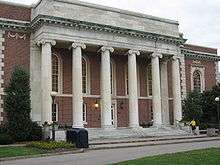
Duke requires its students to live on campus for the first three years of undergraduate life, except for a small percentage of second-semester juniors who are exempted by a lottery system.[71] This requirement is justified by the administration as an effort to help students connect more closely with one another and sustain a sense of belonging within the Duke community.[203] Thus, 85% of undergraduates live on campus.[204] All freshmen are housed in one of 14 residences on East Campus. These buildings range in occupancy size from 50 (Epworth—the oldest residence hall, built in 1892 as "the Inn") to 250 residents (Trinity).[205][206] Most of these are in the Georgian style typical of the East Campus architecture. Although the newer residence halls differ in style, they still relate to East's Georgian heritage. Learning communities connect the residential component of East Campus with students of similar academic and social interests.[207] Similarly, students in FOCUS, a first-year program that features courses clustered around a specific theme, live together in the same residence hall as other students in their cluster.[208]
Sophomores and juniors reside on West Campus, while the majority of undergraduate seniors choose to live off campus.[209] West Campus contains six quadrangles—the four along "Main" West were built in 1930s, while two newer ones have since been added. Central Campus provided housing for over 1,000 students in apartment buildings, until 2019.[210] All housing on West Campus is organized into "houses"—sections of residence halls—to which students can return each year. House residents create their house identities. There are houses of unaffiliated students, as well as wellness houses and living-learning communities that adopt a theme such as the arts or foreign languages. There are also numerous "selective living groups" on campus for students wanting self-selected living arrangements. SLGs are residential groups similar to fraternities or sororities, except they are generally co-ed and unaffiliated with any national organization. Many of them also revolve around a particular interest such as entrepreneurship, civic engagement or African-American or Asian culture. Fifteen fraternities and nine sororities also are housed on campus. Most of the non-fraternity selective living groups are coeducational.[211]
Greek and social life
About 30% of undergraduate men and about 40% of undergraduate women at Duke are members of fraternities and sororities.[204] Most of the 17 Interfraternity Council recognized fraternity chapters live in sections within the residence halls. Eight National Pan-Hellenic Council (historically African American) fraternities and sororities also hold chapters at Duke.[212] The first historically African American Greek letter organization at Duke University was the Omega Psi Phi, Omega Zeta chapter, founded on April 12, 1974. In addition, there are seven other fraternities and sororities that are a part of the Inter-Greek Council, the multicultural Greek umbrella organization.[213] Duke also has Selective Living Groups, or SLGs, on campus for students seeking informal residential communities often built around themes. SLGs are residential groups similar to fraternities or sororities, except they are generally co-ed and unaffiliated with any national organizations.[214] Fraternity chapters and SLGs frequently host social events in their residential sections, which are often open to non-members.[215]
In the late 1990s, a new keg policy was put into effect that requires all student groups to purchase kegs through Duke Dining Services. According to administrators, the rule change was intended as a way to ensure compliance with alcohol consumption laws as well as to increase on-campus safety.[216] Some students saw the administration's increasingly strict policies as an attempt to alter social life at Duke.[217] As a result, off-campus parties at rented houses became more frequent in subsequent years as a way to avoid Duke policies. Many of these houses were situated in the midst of family neighborhoods, prompting residents to complain about excessive noise and other violations. Police have responded by breaking up parties at several houses, handing out citations, and occasionally arresting party-goers.[218] In the mid-to-late 2000s, the administration made a concerted effort to help students re-establish a robust, on-campus social life and has worked with numerous student groups, especially the Duke University Union, to feature a wide array of events and activities. In March 2006, the university purchased 15 houses in the Trinity Park area that Duke students had typically rented and subsequently sold them to individual families in an effort to encourage renovations to the properties and to reduce off-campus partying in the midst of residential neighborhoods.[219][220]
Duke athletics, particularly men's basketball, traditionally serves as a significant component of student life. Duke's students have been recognized as some of the most creative and original fans in all of collegiate athletics.[221] Students, often referred to as Cameron Crazies, show their support of the men's basketball team by "tenting" for home games against key Atlantic Coast Conference opponents, especially rival University of North Carolina at Chapel Hill (UNC).[222] Because tickets to all varsity sports are free to students, they line up for hours before each game, often spending the night on the sidewalk. For a mid-February game against UNC, some of the most eager students might even begin tenting before spring classes begin.[223] The total number of participating tents is capped at 100 (each tent can have up to 12 occupants), though interest is such that it could exceed that number if space permitted.[224] Tenting involves setting up and inhabiting a tent on the grass near Cameron Indoor Stadium, an area known as Krzyzewskiville, or K-Ville for short. There are different categories of tenting based on the length of time and number of people who must be in the tent.[224] At night, K-Ville often turns into the scene of a party or occasional concert. The men's basketball coach, Mike Krzyzewski, occasionally buys pizza for the inhabitants of the tent village.[225]
Activities
Student organizations
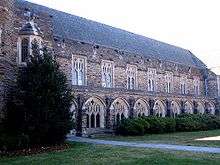
More than 400 student clubs and organizations operate on Duke's campus.[226] These include numerous student government, special interest, and service organizations.[227] Duke Student Government (DSG) charters and provides most of the funding for other student groups and represents students' interests when dealing with the administration.[228] The Duke University Union (DUU) is the school's primary programming organization, serving a center of social, cultural, intellectual and recreational life.[229] There are a number of student-run businesses operating on campus, including Campus Enterprises, which offer students real-world business experience. Cultural groups are provided funding directly from the university via the Multicultural Center as well as other institutional funding sources. One of the most popular activities on campus is competing in sports. Duke has 37 sports clubs, and several intramural teams that are officially recognized. Performance groups such as Hoof 'n' Horn, the country's second-oldest student-run musical theater organization, a cappella groups, student bands, and theater organizations are also prominent on campus.[230] As of the 2016–2017 school year, there are seven a cappella groups recognized by the Duke University A Cappella Council: Deja Blue, Lady Blue, Out of the Blue, the Pitchforks, Rhythm & Blue, Something Borrowed Something Blue, and Speak of the Devil.[231] The Duke University mock trial team won the national championship in 2012.[232] The Duke University Student Dining Advisory Committee provides guidance to the administration on issues regarding student dining, life, and restaurant choices.
Cultural groups on campus include the Asian Students Association, Blue Devils United (the student lesbian, gay, bisexual and transgender group), Black Student Alliance, Diya (South Asian Association), Jewish Life at Duke, Mi Gente (Latino Student Association), International Association/International Council, Muslim Student Association, Native American Student Coalition, Newman Catholic Student Center, Languages Dorm, and Students of the Caribbean.[226][233]
Civic engagement
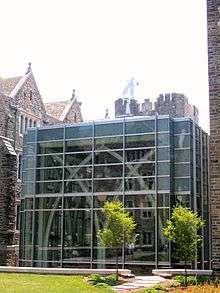
More than 75 percent of Duke students pursue service-learning opportunities in Durham and around the world through DukeEngage and other programs that advance the university's mission of "knowledge in service to society." Launched in 2007, DukeEngage provides full funding for select Duke undergraduates who wish to pursue an immersive summer of service in partnership with a U.S. or international community. As of summer 2013, more than 2,400 Duke students had volunteered through DukeEngage in 75 nations on six continents. Duke students have created more than 30 service organizations in Durham and the surrounding area. Examples include a weeklong camp for children of cancer patients (Camp Kesem) and a group that promotes awareness about sexual health, rape prevention, alcohol and drug use, and eating disorders (Healthy Devils). The Duke-Durham Neighborhood Partnership, started by the Office of Community Affairs in 1996, attempts to address major concerns of local residents and schools by leveraging university resources.[234] Another community project, "Scholarship with a Civic Mission", is a joint program between the Hart Leadership Program and the Kenan Institute for Ethics.[235] Another program includes Project CHILD, a tutoring program involving 80 first-year volunteers; and an after-school program for at-risk students in Durham that was started with $2.25 million grant from the Kellogg Foundation in 2002.[236] Two prominent civic engagement pre-orientation programs also exist for incoming freshmen: Project CHANGE and Project BUILD. Project CHANGE is a free weeklong program co-sponsored by the Kenan Institute for Ethics and the Duke Women's Center with the focus on ethical leadership and social change in the Durham community; students are challenged in a variety of ways and work closely with local non-profits.[237] Project BUILD is a freshman volunteering group that dedicates 3,300 hours of service to a variety of projects such as schools, Habitat for Humanity, food banks, substance rehabilitation centers, homeless shelters. Some courses at Duke incorporate service as part of the curriculum to augment material learned in class such as in psychology or education courses (known as service learning courses).[238]
Student media
The Chronicle, Duke's independent undergraduate daily newspaper, has been continually published since 1905 and now, along with its website, has a readership of about 70,000.[239] Its editors are responsible for selecting the term "Blue Devil". The newspaper won Best in Show in the tabloid division at the 2005 Associated Collegiate Press National College Media Convention.[240] Cable 13, established in 1976, is Duke's student-run television station. It is a popular activity for students interested in film production and media.[241] WXDU, licensed in 1983, is the university's nationally recognized, noncommercial FM radio station, operated by student and community volunteers.[242][243]
The Rival Duke[244] is an online-only, student run publication. The three sections, campus, culture, and current, feature opinion and commentary.
Duke Alumni Association
Duke Alumni Association (DAA) is an alumni association automatically available to all Duke graduates. Benefits include alumni events, a global network of regional DAA alumni chapters, educational and travel opportunities and communications such as The Blue Note, social media and Duke Magazine. It provides access to the Duke Lemur Center, Nasher Museum of Art, Duke Rec Centers and other campus facilities.[245]
Duke Magazine
Duke Magazine, an alumni magazine, is the university's flagship vehicle for stories about the Duke community.[246] It has been published five-six times a year by the Office of Alumni Affairs since 2002.[247]
Athletics
Teams for then Trinity College were known originally as the Trinity Eleven, the Blue and White or the Methodists. William H. Lander, as editor-in-chief, and Mike Bradshaw, as managing editor, of the Trinity Chronicle began the academic year 1922-23 referring to the athletic teams as the Blue Devils. The Chronicle staff continued its use and through repetition, Blue Devils eventually caught on.
The Duke University Athletic Association chairs 27 sports and more than 650 student-athletes. The Blue Devils are members of the National Collegiate Athletic Association (NCAA) Division I level, the Football Bowl Subdivision (FBS) and Atlantic Coast Conference. Men's sports include baseball, basketball, cross country, fencing, football, golf, lacrosse, soccer, swimming & diving, tennis, track & field, and wrestling; women's sports include basketball, cross country, fencing, field hockey, golf, lacrosse, rowing, soccer, softball, swimming & diving, tennis, track & field, and volleyball.[248]
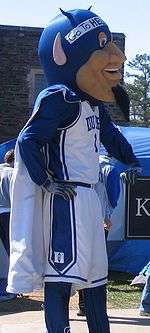
Duke's teams have won 16 NCAA team national championships—the women's golf team has won six (1999, 2002, 2005, 2006, 2007 and 2014), the men's basketball team has won five (1991, 1992, 2001, 2010, and 2015), the men's lacrosse team has won three (2010, 2013, and 2014), and the men's soccer (1986) and women's tennis (2009) teams have won one each.[249] Duke consistently ranks among the top in the National Association of Collegiate Directors of Athletics (NACDA) Directors' Cup, an overall measure of an institution's athletic success. For Division I in 2015, Duke finished 20th overall and fifth in the ACC. The Blue Devils have finished within the top 10 six times since the inception of the Cup in 1993–94. Also, Athletic Director Kevin White earned multiple awards in 2014, including the National Football Foundation's John L. Toner Award.[250]
On the academic front, nine Duke varsity athletics programs registered a perfect 1,000 score in the NCAA's multi-year Academic Progress Report (APR) released in April 2016.[251]
Men's basketball
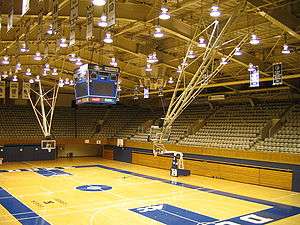
Duke's men's basketball team is one of the nation's most successful basketball programs.[252][253] The team's success has been particularly outstanding over the past 30 years under coach Mike Krzyzewski (often simply called "Coach K"). The Blue Devils are the only team to win five national championships since the NCAA Tournament field was expanded to 64 teams in 1985, 11 Final Fours in the past 25 years, and eight of nine ACC tournament championships from 1999 to 2006. Coach K has also coached the USA men's national basketball team since 2006 and led the team to Olympic golds in 2008, 2012, and 2016. His teams also won World Championship gold in 2010 and 2014. Overall, 32 Duke players[254] have been selected in the first round of the NBA Draft in the Coach K era. More than 50 Duke players have been selected in the NBA Draft.[254]
Football
The Blue Devils have won seven ACC Football Championships, have had ten players honored as ACC Player of the Year (the most in the ACC),[255] and have had three Pro Football Hall of Famers come through the program (second in the ACC to only Miami's four). The Blue Devils have produced 11 College Football Hall of Famers, which is tied for the 2nd most in the ACC. Duke has also won 18 total conference championships (7 ACC, 9 Southern Conference, and 1 Big Five Conference). That total is tied with Clemson for the highest in the ACC.[256]
The most famous Duke football season came in 1938,[257] when Wallace Wade coached the "Iron Dukes" that shut out all regular season opponents; only three teams in history can claim such a feat.[258] That same year, Duke made their first Rose Bowl appearance, where they lost 7–3 when USC scored a touchdown in the final minute of the game.[257] Wade's Blue Devils lost another Rose Bowl to Oregon State in 1942, this one held at Duke's home stadium due to the attack on Pearl Harbor, which resulted in the fear that a large gathering on the West Coast might be in range of Japanese aircraft carriers.[259] The football program proved successful in the 1950s and 1960s, winning six of the first ten ACC football championships from 1953 to 1962 under coach Bill Murray; the Blue Devils would not win the ACC championship again until 1989 under coach Steve Spurrier.[260]
David Cutcliffe was brought in prior to the 2008 season, and amassed more wins in his first season than the previous three years combined. The 2009 team won 5 of 12 games, and was eliminated from bowl contention in the next-to-last game of the season.[261] Mike MacIntyre, the defensive coordinator, was named 2009 Assistant Coach of the Year by the American Football Coaches Association (AFCA).[262]
While the football team has struggled at times on the field, the graduation rate of its players is consistently among the highest among Division I FBS schools. Duke's high graduation rates have earned it more AFCA Academic Achievement Awards than any other institution.[263]
In 2012, the Duke football team made its first bowl game appearance since 1994[264] with a win over arch-rival North Carolina, a bowl which they would lose to the Cincinnati Bearcats in the by a score of 48–34.[265]
2013 marked the beginning of the Blue Devils' recent but relative success, having a breakout 10–2, 6-2 (ACC)[266] season while claiming the title of Coastal Division Champions.[267] Duke would go on to play the Florida State Seminoles in the ACC Championship game where they would lose to the national champions 45–7.[268] Duke received an invite to the Chick-fil-a Peach Bowl that same year in which they took on the Texas A&M Aggies led by college football legend Johnny Manziel, losing by a score of 52–48.[269]
For the 2014 season, Duke finished 9–3, 5–3 (ACC) and earned a trip to the Sun Bowl,[270] where the Blue Devils lost to the Pac-12's Arizona State 36–31. In 2015, the Detroit Lions drafted Duke offensive guard Laken Tomlinson[271] and the Washington Redskins drafted wide receiver Jamison Crowder.[272] In 2019, Duke quarterback Daniel Jones was drafted 6th overall by the New York Giants.[273]
Track and field
In 2003 Norm Ogilvie was promoted to Director of Track and Field, and has led athletes to over 60 individual ACC championships, and 81 All-America selections, along with most of the track and field records being broken during his tenure.[274] A new facility, the Morris Williams Track and Field Stadium, opened in 2015.[275]
Notable people
Duke's active alumni base of more than 145,000 devote themselves to the university through organizations and events such as the annual Reunion Weekend and Homecoming.[276] There are 75 Duke clubs in the U.S. and 38 such international clubs.[277] For the 2008–09 fiscal year, Duke tied for third in alumni giving rate among U.S. colleges and universities according to U.S. News & World Report.[278] Based on statistics compiled by PayScale in 2011, Duke alumni rank seventh in mid-career median salary among all U.S. colleges and universities.[279] A number of alumni have made significant contributions in the fields of government, law, science, academia, business, arts, journalism, and athletics, among others.
Rhodes Scholars
Among academic achievements at Duke, three students were named Rhodes Scholars in both 2002 and 2006, a number surpassed only by Harvard in 2002 and the United States Military Academy in 2006.[280][281] Overall, Duke has produced 50 through 2019, including 28 between 1990 and 2019.[282]
Government
Richard Nixon, 37th President of the United States graduated with a law degree in 1937.[283] Former U.S. Senator and Secretary of Transportation Elizabeth Dole,[284] 33rd President of Chile Ricardo Lagos,[285] former U.S. Secretary of Commerce Juanita M. Kreps,[286] congressman and three-time presidential candidate Ron Paul,[287] U.S. Secretary of Veterans Affairs and former Chief of Staff of the United States Army Eric Shinseki,[288] and the first United States Chief Performance Officer Jeffrey Zients[289] and Chairman of the Joint Chiefs of Staff Martin Dempsey are among the most notable alumni with involvement in politics and government. Sheikha Al-Mayassa bint Hamad bin Khalifa Al-Thani serves as the Chairperson of Qatar Museums Authority.[290] Kevin Martin was Chairman of the FCC.[291] Rex Adams serves as the Chairman of PBS.[292] Amit Mitra, finance minister of the Indian state of West Bengal.
Academia and research
Duke affiliates who have won the Nobel Prize in Physics include Hans Dehmelt for his development of the ion trap technique,[293] Robert Richardson for his discovery of superfluidity in helium-3,[294] and Charles Townes for his work on quantum electronics.[295] Other alumni in research and academia include Turing Award winners Fred Brooks,[296] Edmund M. Clarke[297] and John Cocke,[298] Templeton Prize winning physicist and religion scholar Ian Barbour,[299] MacArthur Award recipient Paul Farmer,[300] and former Dean of the Graduate School at Princeton Theodore Ziolkowski.[301] Duke professor Robert J. Lefkowitz shared the 2012 Nobel Prize in Chemistry, Professor Paul Modrich shared the 2015 Nobel Prize in Chemistry, and Ingrid Daubechies, currently a James B. Duke professor of mathematics, served as the first woman president of the International Mathematical Union and is known for pioneering work on Wavelets.
Journalism
Prominent journalists include talk show host Charlie Rose,[302] The Washington Post sports writer John Feinstein,[303] Chief Washington Correspondent for CNBC and The Wall Street Journal writer John Harwood,[304] CBS News President Sean McManus,[305] chief legal correspondent for Good Morning America Dan Abrams,[306][307] and CNN anchor and senior correspondent for The NewsHour with Jim Lehrer Judy Woodruff.[308] Basketball analysts and commentators include Jay Bilas,[309][310] Mike Gminski,[311] Jim Spanarkel,[312] and Jay Williams.[313] Magazine editors include Rik Kirkland of Fortune[314] and Clay Felker, founder of New York Magazine.[315]
Literature
In the area of literature, William Styron won the Pulitzer Prize for Fiction in 1968 for his novel The Confessions of Nat Turner and is well known for his 1979 novel Sophie's Choice.[316] Anne Tyler also received the Pulitzer Prize for her 1988 novel Breathing Lessons.[317] Additionally, Elizabeth A. Fenn won the Pulitzer Prize for History in 2015. Other acclaimed writers include John W. Campbell and Reynolds Price.
In the visual arts realm, Cody Ko (Youtuber, developer, podcaster and musician), Annabeth Gish[318] (actress in the X-Files and The West Wing), Ken Jeong[319] (actor in The Hangover and Community), Retta[320] (actress and comedian), Jared Harris (actor in Mad Men), Randall Wallace[321] (screenwriter, producer, and director, Braveheart, Pearl Harbor, We Were Soldiers), Mike Posner[322] (singer, songwriter, and producer, "Cooler Than Me", "Please Don't Go", "I Took A Pill in Ibiza"), David Hudgins[323] (television writer and producer, Everwood, Friday Night Lights), Robert Yeoman (cinematographer, The Grand Budapest Hotel), photographer Mikael Owunna headline the list.
Business
The current or recent president, CEO, or chairman of each of the following Fortune 500 companies is a Duke alumnus: Apple (Tim Cook),[324] Bear Stearns (Alan Schwartz), BB&T (John A. Allison IV),[325] Chesapeake Energy (Aubrey McClendon),[326] Cisco Systems (John Chambers), General Motors (Rick Wagoner),[327] Ingersoll Rand (Michael Lamach), JPMorgan Chase (Steven Black),[328] Kaplan (Andrew S. Rosen), Medtronic (William A. Hawkins),[329] Morgan Stanley and Credit Suisse First Boston (John J. Mack),[330] Norfolk Southern (David R. Goode),[331] Northwest Airlines (Gary L. Wilson),[332] Panda Restaurant Group (Tom Davin), PepsiCo (Karl von der Heyden),[333] Procter & Gamble (David S. Taylor),[334] Pfizer (Edmund T. Pratt, Jr.),[335] The Bank of New York Mellon (Gerald Hassell),[336] Wachovia (Robert K. Steel),[337] Volkswagen (Jonathan Browning).
Companies founded by Duke alumni include the nation's wealthiest charitable foundation[338] at $31.9 billion:[339] Bill & Melinda Gates Foundation (Melinda Gates),[340] The Carlyle Group (David Rubenstein), Boston Scientific (Peter Nicholas),[341] The Pritzker Group, principal owner of Hyatt Hotels and TransUnion (J. B. Pritzker), PIMCO (William Gross), and 1-800-Flowers (Granville Semmes).
Recent notable startups founded by Duke alumni include Box (Dylan Smith), Yext (Howard Lerman), Mint (Aaron Patzer), Coinbase (Fred Ehrsam), Plaid (Zach Perret), Duolingo (Luis Von Ahn), Airtable (Howie Liu), and Neuralink (Max Hodak).
Athletics
Management and ownership of professional athletic franchises include Adam Silver (NBA commissioner), John P. Angelos[342] (Executive Vice President of the Baltimore Orioles), Aubrey McClendon[343] (former part owner of the Oklahoma City Thunder), John Canning, Jr.[344] (co-owner of Milwaukee Brewers), Danny Ferry[345] (former general manager of the Cleveland Cavaliers), Stephen Pagliuca[346] (co-owner of Boston Celtics), and Jeffrey Vinik[347] (owner of the Tampa Bay Lightning).
Several athletes have become stars at the professional level, especially in basketball's NBA. Art Heyman, Shane Battier, Corey Maggette, Elton Brand, Carlos Boozer, Luol Deng, Christian Laettner, Bobby Hurley, Grant Hill, J. J. Redick, Grayson Allen, Jabari Parker, Jayson Tatum, Brandon Ingram, Jahlil Okafor, Zion Williamson and NBA Champion Kyrie Irving are among the most famous.[348] Offensive linesman Lennie Friedman played for four National Football League teams, and Ed Newman was an All-Pro offensive lineman.[349][350]
Men's basketball coach Mike Krzyzewski led the US men's team to three gold medals[351] (2008, 2012, 2016), and Abigail Johnston won a silver medal in synchronized diving at the 2012 Summer Olympics while an undergraduate at Duke and competed in the 2016 Summer Olympics while attending Duke Medical School.[352] Ibtihaj Muhammad was the first woman to compete at the Olympic Games while wearing a hijab and became the first female Muslim-American athlete to earn an Olympic medal at the 2016 Summer Olympics.[353]
References
- King, William E. "Shield, Seal and Motto". Duke University Archives. Retrieved November 30, 2016.
- "About – Duke Divinity School". Duke Divinity School. Archived from the original on July 2, 2011. Retrieved July 4, 2011.
- "Duke University's Relation to the Methodist Church: the basics". Duke University. 2002. Archived from the original on June 12, 2010. Retrieved March 27, 2010.
Duke University has historical, formal, on-going, and symbolic ties with Methodism, but is an independent and non-sectarian institution ... Duke would not be the institution it is today without its ties to the Methodist Church. However, the Methodist Church does not own or direct the University. Duke is and has developed as a private nonprofit corporation which is owned and governed by an autonomous and self-perpetuating Board of Trustees
- "United Methodist schools score high in rankings". The United Methodist Church. Archived from the original on July 1, 2012. Retrieved June 30, 2007.
- Separated brethren: a review of Protestant, Anglican, Eastern Orthodox & other religions in the United States. Our Sunday Visitor. 2002. ISBN 978-1-931709-05-7.
- "Duke University". International Association of Methodist-related Schools, Colleges, and Universities (IAMSCU). Archived from the original on October 6, 2007. Retrieved June 30, 2007.
- As of June 30, 2019. "U.S. and Canadian 2019 NTSE Participating Institutions Listed by Fiscal Year 2019 Endowment Market Value, and Percentage Change in Market Value from FY18 to FY19 (Revised)". National Association of College and University Business Officers and TIAA. Retrieved April 21, 2020.
- "About the Duke Endowment". The Duke Endowment. Retrieved May 21, 2019.
- Satisky, Jake (May 11, 2019). "Board of Trustees discusses task forces, approves $2.8 billion budget at May meeting". The Chronicle.
- "A First Day as President-Elect is a Memorable One". December 3, 2016. Archived from the original on August 11, 2017. Retrieved July 1, 2017.
- "Duke Facts". Duke University. Retrieved December 7, 2019.
- "The Origin of Duke Blue". Duke University Archives. Retrieved March 1, 2017.
- "Color Palette". Duke University. Retrieved March 1, 2017.
- King, William E. "Duke University: A Brief Narrative History". Duke University Archives. Retrieved May 23, 2011.
- McGuinness, William (January 2, 2013). "Duke Readies For China Campus Amid Controversy". HuffPost. Retrieved March 3, 2020.
- "GLOBAL LIST OF HIGHLY CITED PUTS DUKE IN TOP TEN".
- "Duke Senior Gabriella Deich Named Rhodes Scholar". today.duke.edu. Retrieved March 3, 2020.
- "Colleges and Universities with U.S. Rhodes Scholarship Winners | The Rhodes Scholarships". www.rhodesscholar.org. Retrieved May 31, 2019.
- Top Scholar Rankings: 1986–2015 Archived September 5, 2015, at the Wayback Machine . Kansas State University, 2015. Retrieved September 16, 2015.
- Elkins, Kathleen. "Billionaire Universities". Forbes.
- "North Carolina's Largest Private Employers" (PDF). Archived from the original (PDF) on March 8, 2016. Retrieved July 31, 2017.
- https://facts.duke.edu
- "America's Best Employers". Retrieved February 13, 2018.
- "Great Colleges To Work For 2015". July 19, 2015. Retrieved February 13, 2018.
- "A Chronology of Significant Events in Duke University's History". Duke University Archives. Retrieved May 23, 2011.
- Pyatt, Tim (November–December 2006). "Retrospective: Selections from University Archives". Duke Magazine. Duke Office of Alumni Affairs. 92 (6). Archived from the original on May 15, 2011. Retrieved May 23, 2011.
- Duke University Chapel – History Archived May 2, 2012, at the Wayback Machine . Friends of Duke Chapel. Retrieved July 5, 2011.
- King, William, E. (1997). "Washington Duke and the Education of Women". University Archives. David M. Rubenstein Rare Book & Manuscript Library. Retrieved March 24, 2015.
- "Navy V-12 Program". Durham, North Carolina: Duke University. 2011. Archived from the original on March 5, 2011. Retrieved September 28, 2011.
- Marianne Twu (2010). "Slavery and Segregation". Duke Human Rights Center. Retrieved January 8, 2016.
- "Celebrating the Past, Charting the Future: Commemorating 50 Years of Black Students at Duke University". Retrieved July 27, 2019.
- "The Road to Desegregation". Duke University. Archived from the original on February 12, 2019. Retrieved January 28, 2019.
- Duke Annual Report 2000/2001-Interdisciplinary Archived July 24, 2012, at Archive.today . Duke University Annual Report, 2001. Retrieved January 12, 2011.
- Rogalski, Jim. Breaking the Barrier: A History of African-Americans at Duke University School of Medicine. Inside DUMC, February 20, 2006. Retrieved January 12, 2011.
- Mock, Geoffrey. Duke's Black Faculty Initiative Reaches Goal Early. Duke University Office of News and Communication, November 21, 2002. Retrieved January 12, 2011.
- "The Top American Research Universities" (PDF). Center for Measuring University Performance. 2010. Archived from the original (PDF) on May 16, 2011. Retrieved February 25, 2011.
- "Duke Today".
- Academic, Cultural and Research Centers Archived March 4, 2011, at the Wayback Machine . Duke University Admissions. Retrieved April 3, 2011.
- Phillip, Abby (June 17, 2014). "This Duke dorm is no longer named after a white supremacist former governor". Washington Post.
- "Duke University Removes Robert E. Lee Statue From Chapel Entrance". NPR.org. Retrieved August 24, 2017.
- "Duke University removes damaged Robert E. Lee statue". Washington Post. Archived from the original on August 25, 2017. Retrieved August 24, 2017.
- "Duke University removes contentious Confederate statue after vandalism". Reuters. August 19, 2017. Retrieved August 24, 2017.
- "Robert E. Lee statue removed at Duke". New York Post. Associated Press. August 19, 2017. Retrieved August 24, 2017.
- Civil rights protesters confess to defacing Confederate statues. New York Post. Retrieved August 24, 2017.
- Associated Press (November 22, 2013). "North Carolina: Woman in Duke case guilty in killing". The New York Times. Retrieved March 9, 2019.
- Yamato, Jen (March 12, 2016). "The stripper who cried 'rape': Revisiting the Duke lacrosse case ten years later". The Daily Beast. Retrieved March 9, 2019.
- Deitsch, Richard (March 9, 2016). "New ESPN 30 for 30 documentary to look back at Duke lacrosse case". Sports Illustrated. Retrieved March 28, 2016.
- "N.C. attorney general: Duke players 'innocent'". CNN. April 11, 2007. Retrieved March 9, 2019.
- Beard, Aaron (April 11, 2007). "Prosecutors Drop Charges in Duke Case". The San Francisco Chronicle. Associated Press. Archived from the original on May 26, 2007. Retrieved April 11, 2007.
- Setrakian, Lara; Francescani, Chris (June 16, 2007). "Former Duke Prosecutor Nifong Disbarred". ABC News. Raleigh, N.C. Retrieved May 12, 2015.
- "Duke University Agrees to Pay U.S. $112.5 Million to Settle False Claims Act Allegations Related to Scientific Research Misconduct". www.justice.gov. March 25, 2019.
- Duke University pays $112.5 million in fake research case sparked by whistleblower, Reuters March 25, 2019
- "Duke Today".
- "Duke Chronicle".
- "Duke University: Office of the University Architect Collegiate Gothic Style". Duke Office of the University Architect. Archived from the original on March 4, 2011. Retrieved February 25, 2011.
- Rubin, Brad (October 17, 1993). "Campus Correspondence : Separate by Choice: Racial Segregation at Duke". LA Times.
- Williams, Ryan (August 29, 2018). "Dear Duke administration: Do better". The Chronicle.
- Julian Abele, Architect. Duke University Archives. Retrieved June 21, 2011.
- "America's most beautiful college campuses", Travel+Leisure (September, 2011)
- King, William E. DukeStone. Duke University Historical Notes. Retrieved January 12, 2011.
- Duke Chapel Durham. NBC17 News. Retrieved July 4, 2011.
- Ramkumar, Amrith (June 15, 2015). "Wallace Wade renovations on track as Cameron Indoor addition begins". The Chronicle. Retrieved August 11, 2016.
- "Environment Hall – Nicholas School". Archived from the original on October 11, 2016. Retrieved August 11, 2016.
- "Dedication Ceremony for the New Wing of the Christine Siegler Pearson Building". March 26, 2014. Retrieved August 11, 2016.
- "Rubenstein Library Renovation". blogs.library.duke.edu. Archived from the original on July 6, 2016. Retrieved August 11, 2016.
- "Construction Highlights Duke's Summer". Retrieved August 11, 2016.
- "New Awards for Historic Baldwin Auditorium". Retrieved August 11, 2016.
- Mueller, Jared. Campus reaps benefits of facilities boom. The Chronicle, November 1, 2005. Retrieved January 12, 2011.
- Dagger, Jacob. Stones, Bricks, and Mortar: Building for Success Archived March 19, 2012, at the Wayback Machine. Duke Magazine, March–April 2006. Retrieved January 12, 2011.
- Muoio, Danielle; Spector, Julian (February 23, 2012). "Cancer Center opens this week". The Chronicle. Retrieved August 11, 2016.
- RLHS: Housing Archived March 19, 2012, at the Wayback Machine. Duke Residence Life and Housing Services. Retrieved May 3, 2011.
- "Duke University West Campus Quads".
- Cameron Indoor Stadium. Duke University. Retrieved June 21, 2011. Archived January 13, 2009, at the Wayback Machine
- "East Campus: History of East Campus". Duke University Libraries. Archived from the original on March 5, 2011. Retrieved June 21, 2011.
- "Duke University East Campus Quads".
- "Duke University Central Campus". Duke University.
- "The days of Central Campus student housing at Duke University are drawing to close". heraldsun. Retrieved March 8, 2019.
- Central Campus Archived March 19, 2012, at the Wayback Machine. Duke Student Affairs. Retrieved May 3, 2011.
- 75 Years of Duke Forest. Duke Today, October 6, 2006. Retrieved July 18, 2011.
- Duke Forest Archived August 6, 2010, at the Wayback Machine. Duke Forest. Retrieved June 21, 2011.
- Duke University Admissions: Duke Forest Archived March 4, 2011, at the Wayback Machine . Duke Admissions. Retrieved May 3, 2011.
- Duke's Secret in the Forest Archived November 1, 2012, at the Wayback Machine . The Herald-Sun, 2010. Retrieved July 18, 2011.
- Lillard, Margaret. Duke lemur center has new research focus. The Associated Press, June 4, 2006. Retrieved June 21, 2011.
- The Sarah P. Duke Gardens History. Duke Gardens. Retrieved July 5, 2011.
- Duke University Medical Center. U.S. News & World Report, 2011. Retrieved July 18, 2011.
- Best Medical Schools: Research Archived April 15, 2012, at the Wayback Machine. U.S. News & World Report, 2011. Retrieved July 18, 2011.
- DukeMedNews Archived March 4, 2010, at the Wayback Machine. DukeMed News, July 30, 2010. Retrieved July 30, 2011.
- Duke University Marine Lab Archived June 22, 2007, at the Wayback Machine. Duke Marine Lab. Retrieved June 21, 2011.
- "Marine Lab's Newest Research Building Showcases Sustainable Coastal Design". Duke University. May 12, 2014. Archived from the original on June 6, 2014.
- "Duke NUS Story". www.duke-nus.edu.sg. Archived from the original on November 19, 2018. Retrieved November 20, 2018.
- "Duke NUS Medical School". www.duke-nus.edu.sg.
- Duke University Partners with National University of Singapore to Establish New Medical School Archived September 28, 2011, at the Wayback Machine. Duke Medicine News and Communications. Retrieved August 15, 2011.
- "Duke NUS Story". www.duke-nus.edu.sg.
- "Duke Kunshan". dukekunshan.edu.
- "About | Duke Kunshan University". dukekunshan.edu.cn. Retrieved November 19, 2018.
- Oleniacz, Laura (August 8, 2014). "Duke Kunshan University campus in China nears opening". The Herald-Sun. Archived from the original on February 14, 2015. Retrieved April 6, 2015.
- "Duke at a Glance" (PDF). Duke University's Office of News & Communications. Archived from the original (PDF) on February 2, 2017. Retrieved January 25, 2017.
- "Undergraduate Degree - Duke Kunshan University". Duke Kunshan University. Retrieved November 19, 2018.
- "Duke University's Relation to the Methodist Church: the basics". Duke University. 2002. Archived from the original on June 12, 2010. Retrieved March 27, 2010.
Duke University has historical, formal, on-going, and symbolic ties with Methodism, but is an independent and non-sectarian institution.
- "UCAR joins National Lambda Rail". SCD News. Retrieved June 12, 2011.
- Duke Tip Academy Archived May 23, 2011, at the Wayback Machine . Duke TIP. Retrieved July 4, 2011.
- "Duke University admits record-low 5.7 percent of regular decision applicants". The Chronicle. Retrieved March 29, 2019.
- "Duke Breaks its Record for Number of Applications Received". Duke Chronicle. Retrieved February 22, 2018.
- "Data" (PDF). admissions.duke.edu. Archived from the original (PDF) on July 17, 2019. Retrieved May 21, 2019.
- Recently Elected U.S. Rhodes Scholars. The Rhodes Trust. Retrieved January 12, 2011.
- "Duke Gates Scholar 2007". The Gates Cambridge Scholarship. Archived from the original on October 3, 2011. Retrieved July 4, 2011.
- Twenty-two Duke Graduates, Grad Students Receive Fulbright Scholarships. Duke News & Communications, September 26, 2005. Retrieved January 12, 2011.
- Dunning, Denise. Trinity Juniors receive Truman scholarships. Archived March 5, 2011, at the Wayback Machine The Chronicle, March 22, 1996. Retrieved May 23, 2011.
- "Colleges That Are the Most Generous to the Financially Neediest Students". The Chronicle of Higher Education. Retrieved February 14, 2020.
- Financial Aid Statistics Archived May 6, 2011, at the Wayback Machine . Duke Financial Aid. Retrieved May 3, 2011.
- Medical School: Duke University. Archived October 4, 2011, at the Wayback Machine Duke University Health System. Retrieved August 25, 2011.
- Duke University School of Medicine. Top Medical Schools in U.S.A., 2011. Retrieved August 25, 2011.
- Education: Duke University School of Medicine. Duke School of Medicine, 2010. Retrieved August 25, 2011.
- Duke University School of Medicine. Admission Hub, 2007. Retrieved July 9, 2011.
- Duke Law: Class Profiles, Duke Law Admissions, 2009. Retrieved July 24, 2011.
- Duke homepage – Schools tab, Duke University. Retrieved June 12, 2011.
- Majors, Minors & Schools. Duke Admissions, 2012. Retrieved November 26, 2012.
- About Pratt. Pratt School of Engineering. Retrieved January 12, 2011.
- Curriculum 2000: Index of the Report Archived June 10, 2007, at the Wayback Machine . Duke University. Retrieved June 12, 2011.
- Focus: Introduction: What is Focus? Archived April 20, 2009, at the Wayback Machine. Duke University. Retrieved June 12, 2011.
- "Duke Pratt School of Engineering-Inspiring Engineers". pratt.duke.edu. Duke University. Retrieved October 16, 2019.
- "Real-World Design". pratt.duke.edu. Duke University. Retrieved October 16, 2019.
- "Research Fellowships and Independent Study". pratt.duke.edu. Duke University. Retrieved October 16, 2019.
- "About Duke Engineering". pratt.duke.edu. Duke University. Retrieved October 16, 2019.
- Nasher Museum of Art at Duke University. Nasher Museum of Art at Duke University. Retrieved June 21, 2011.
- "Table 20. Higher education R&D expenditures, ranked by FY 2018 R&D expenditures: FYs 2009–18". National Science Foundation. Retrieved May 2, 2020.
- "NIH Awards by Location & Organization". National Institutes of Health. Archived from the original on May 10, 2020. Retrieved May 2, 2020.
- "Carnegie Classifications Institution Lookup". carnegieclassifications.iu.edu. Center for Postsecondary Education. Retrieved July 18, 2020.
- Research Duke BME. Pratt School of Engineering. Retrieved January 12, 2011.
- "Robert Lefkowitz Shares Nobel Prize in Chemistry". Duke Today. Retrieved September 2, 2015.
- "Final genome 'chapter' published". BBC News. Retrieved January 12, 2011.
- "AIDS Vaccine Research Offers New Insights On Survival". Medical News Today, June 13, 2006. Retrieved January 12, 2011.
- Elshtain, Jean Bethke. An Honored Prophet: Stanley Hauerwas: "America's Best Theologian". Touchstone Journal. Retrieved July 4, 2011.
- Fredric Jameson, William A. Lane Professor of Comparative Literature and Romance Studies. Duke University. Retrieved June 12, 2011.
- Vulliamy, Ed. The Observer Profile: Michael Hardt. The Observer, July 15, 2001. Retrieved June 12, 2011.
- Philosophical Gourmet Report: Breakdown: Philosophy of Biology. Philosophical Gourmet Report. Retrieved July 4, 2011.
- "Faculty Scholarly Productivity Index". Chronicle. Archived from the original on February 3, 2014.
- "Academic Ranking of World Universities 2020: National/Regional Rank". Shanghai Ranking Consultancy. Retrieved August 15, 2020.
- "America's Top Colleges 2019". Forbes. Retrieved August 15, 2019.
- "U.S. College Rankings 2020". Wall Street Journal/Times Higher Education. Retrieved September 26, 2019.
- "Best Colleges 2020: National University Rankings". U.S. News & World Report. Retrieved September 8, 2019.
- "2019 National University Rankings". Washington Monthly. Retrieved August 20, 2019.
- "Academic Ranking of World Universities 2020". Shanghai Ranking Consultancy. 2020. Retrieved August 15, 2020.
- "QS World University Rankings® 2021". Quacquarelli Symonds Limited. 2020. Retrieved June 10, 2020.
- "World University Rankings 2020". THE Education Ltd. Retrieved September 14, 2019.
- "Best Global Universities Rankings: 2020". U.S. News & World Report LP. Retrieved October 22, 2019.
- "Duke University – U.S. News Best Grad School Rankings". U.S. News & World Report. Retrieved April 26, 2020.
- "Duke University – U.S. News Best Global University Rankings". U.S. News & World Report. Retrieved April 26, 2020.
- Duke Places Eighth in U.S. News Ranking. Duke University News & Communications, August 18, 2006. Retrieved January 12, 2011.
- "2020 Best Colleges in America". Niche. Retrieved September 17, 2019.
- "UPenn named best college nationwide for 2015".
- "Kiplinger's Best College Values". Retrieved April 9, 2017.
- "College Rankings". The Wall Street Journal. 2016. Retrieved September 30, 2016.
- "Here's a New College Ranking, Based Entirely on Other College Rankings". The Washington Post.
- "Best College: Nationwide". College Factual.
- "The top 50 colleges in America". Business Insider.
- "Top colleges for a major in economics". USA Today College. Archived from the original on September 6, 2015. Retrieved September 2, 2015.
- "The 10 best U.S. colleges for a major in psychology". USA Today College. Archived from the original on August 21, 2015. Retrieved September 2, 2015.
- "The 50 best computer-science and engineering schools in America". Retrieved September 2, 2015.
- "Duke Reclaims Title as Best School in U.S. for Economics | Duke Economics Department". econ.duke.edu. Retrieved September 14, 2018.
- "Top Global Universities".
- "World University Rankings". Times Higher Education (THE). August 20, 2019. Retrieved April 12, 2020.
- "QS World University Rankings 2020". Top Universities. June 5, 2019. Retrieved April 12, 2020.
- "Duke University | Academic Ranking of World Universities - 2019 | Shanghai Ranking - 2019". www.shanghairanking.com. Retrieved April 12, 2020.
- What Business Leaders Says. The New York Times, October 20, 2011. Retrieved December 30, 2011.
- Gauging the Value of Your M.B.A.. The New York Times, October 19, 2011. Retrieved December 30, 2011.
- "Best universities for graduate jobs: Global University Employability Ranking 2019". Times Higher Education (THE). November 21, 2019. Retrieved April 12, 2020.
- "National Merit Scholarship Corporation 2017–18 Annual Report" (PDF).
- "Churchill Scholars". The Winston Churchill Foundation of the United States. Retrieved September 30, 2016.
- Kiplinger's Sortable Rankings of Private College Values Archived September 10, 2010, at the Wayback Machine. Kiplinger. Retrieved July 6, 2011.
- Peterson-Withorn, Chase. "The 28 Schools That Mint The Most Billionaire Alumni". Forbes. Retrieved April 12, 2020.
- Ranking America's Leading Universities on Their Success in Integrating African Americans Archived July 1, 2006, at the Wayback Machine . The Journal of Blacks in Higher Education, 2002. Retrieved January 12, 2011.
- "Global Companies Rank Universities". NYTimes.com. October 25, 2012. Retrieved August 16, 2013.
- "Power Factories". Forbes.
- "The World's Most Innovative Universities". Thomson Reuters.
- "Obama Won't Rate Colleges, So We Did". NPR. September 15, 2015.
- "Best 50 Colleges for African Americans". Time. Retrieved April 12, 2016.
- "Expensive Schools Worth Every Penny". Forbes. Retrieved April 17, 2016.
- "America's Best Large Employers". Forbes. Retrieved April 19, 2019.
- "WSJ rankings place Duke in No. 1 spot for graduate outcomes". The Chronicle. Retrieved April 19, 2019.
- "Duke ties with Harvard and Yale in Wall Street Journal student outcomes ranking". The Chronicle. Retrieved April 19, 2019.
- Best Medical Schools 2017: Research. Archived April 22, 2014, at the Wayback Machine U.S. News & World Report.
- "Best Medical Schools 2018: Primary Care". U.S. News & World Report. Archived from the original on April 21, 2010. Retrieved April 5, 2017.
- Best Law Schools 2017. U.S. News & World Report.
- Best Nursing Schools 2018. U.S. News & World Report.
- Best Public Policy Analysis Programs 2019. U.S. News & World Report.
- America's Best Graduate Schools 2018. U.S. News & World Report.
- The Complete 2014 Business Schools Ranking Archived November 24, 2014, at the Wayback Machine. Bloomberg Businessweek.
- . U.S. News & World Report.
- THE – Top institutions in Mathematics. Times Higher Education, 2011. Retrieved June 16, 2011.
- Duke University: Overall Rankings. U.S. News & World Report, 2011. Retrieved August 3, 2011.
- "Duke faculty more productive than peers, according to study". The Herald-Sun. Archived from the original on October 19, 2012. Retrieved November 27, 2012.
- Smith, Jacquelyn. "The 25 Law Schools Whose Grads Earn The Most". Forbes.
- Ranked N°3 – Master of Engineering Management (MEM) – Duke University. Best-masters.us. Retrieved on July 29, 2013.
- Duke University – In Photos: The Grateful Grads Index: The Top 50 ROI Colleges. Forbes. Retrieved on July 29, 2013.
- The ATL Top 50 Law School Rankings 2018 " Above the Law: A Legal Web Site – News, Commentary, and Opinions on Law Firms, Lawyers, Law Schools, Law Suits, Judges, and Courts + Career Resources. Abovethelaw.com. Retrieved on July 1, 2018.
- Best Business Schools In The World. Business Insider (July 17, 2013). Retrieved on July 29, 2013.
- "Best Global Universities Ranking – 2014". U.S. News & World Report. Archived from the original on November 27, 2015.
- "2014–2015 World Ranking (1–250)". University Ranking by Academic Performance. 2014. Retrieved November 8, 2015.
- Love, Maggie. "Uni analyzes impact of new housing model on diversity", The Chronicle, November 8, 2010. Retrieved July 5, 2011.
- See Demographics of the United States for references.
- Aisch, Gregor; Buchanan, Larry; Cox, Amanda; Quealy, Kevin (January 18, 2017). "Economic diversity and student outcomes at Duke". The New York Times. Retrieved August 9, 2020.
- RLHS: Mission Archived October 11, 2010, at the Wayback Machine. Duke Residence Life and Housing Services. Retrieved May 3, 2011.
- Campus Life. U.S. News & World Report. Retrieved January 12, 2011. Archived April 12, 2008, at the Wayback Machine
- Epworth Archived March 19, 2012, at the Wayback Machine. Duke Residence Life and Housing Services. Retrieved May 3, 2011.
- Gilbert-Addoms Archived March 19, 2012, at the Wayback Machine. Duke Residence Life and Housing Services. Retrieved May 3, 2011.
- RLHS: Communities Archived March 19, 2012, at the Wayback Machine. Duke Residence Life and Housing Services. Retrieved May 3, 2011.
- About FOCUS Archived August 2, 2012, at the Wayback Machine. Duke University. Retrieved August 1, 2011.
- Bishop, Eric. Record number of seniors to leave campus housing. The Chronicle, July 19, 2005. Retrieved July 7, 2011.
- Central Campus Archived March 19, 2012, at the Wayback Machine . Duke Residence Life and Housing Services. Retrieved July 7, 2011.
- Living Groups on Campus Archived March 19, 2012, at the Wayback Machine . Duke Residence Life and Housing Services. Retrieved July 7, 2011.
- National Pan-Hellenic Council Archived March 19, 2012, at the Wayback Machine. Duke University. Retrieved June 28, 2011.
- Inter-Greek Council Archived March 19, 2012, at the Wayback Machine. Duke University. Retrieved June 28, 2011.
- Current Living Groups. Archived February 26, 2014, at the Wayback Machine Duke University Student Affairs. Retrieved February 23, 2014.
- Fraternity Housing Sections Archived March 19, 2012, at the Wayback Machine, Duke Office of Fraternity & Sorority Life. Retrieved July 4, 2011.
- Moulton, Jessica (March 17, 1996). "Keg prices reduced by $10; bartenders remain expensive". The Chronicle. Retrieved January 12, 2011.
- DeLuca, Jerry and Vrettos, Christopher. Honestly, the administration wants no kegs Archived March 1, 2013, at Archive.today. The Chronicle. Retrieved January 12, 2011.
- Mueller, Jared. Buchanan Blues. The Chronicle, April 29, 2006. Retrieved January 12, 2011.
- Eaglin, Adam. Duke to sell 5 off-East houses. The Chronicle, June 1, 2006. Retrieved April 17, 2011.
- Englander, Dan (February 28, 2006). "University buys off-East houses". The Chronicle. Retrieved April 9, 2017.
- Cameron's Craziest. ESPN, 2002. Retrieved January 12, 2011.
- Nathan, Vignesh. K-Ville Bills: One Student's Plan to Better Tenting Archived October 13, 2011, at the Wayback Machine . Towerview Magazine, February 9, 2011.
- McCartney, Ryan. DSG presents a revised draft of tenting policy. The Chronicle, October 26, 2005. Retrieved August 1, 2011.
- Brill, Bill. Duke basketball: 100 seasons: a legacy of achievement, p. 97. Sports Publishing L.L.C, 2004. Retrieved August 25, 2011.
- Kville Archived July 28, 2012, at Archive.today . Duke Student Government. Retrieved January 12, 2011.
- Duke Student Organizations Archived March 19, 2012, at the Wayback Machine. Duke Student Affairs. Retrieved July 4, 2011.
- Non-profit organization. Archived July 19, 2009, at the Wayback Machine , Duke University Office of Student Activities and Facilities, July 1, 2009. Retrieved July 1, 2011.
- Duke Student Government. Duke Student Government. Retrieved January 12, 2011.
- About DUU. Archived August 15, 2011, at the Wayback Machine Duke University Union. Retrieved August 22, 2011.
- Hoof 'n' Horn. Duke Hoof 'n' Horn. Retrieved July 4, 2011.
- Duke A Cappella Council. Duke University A Cappella Council. Retrieved April 17, 2017.
- "National Championship Final Round Results". American Mock Trial Association. Retrieved September 30, 2016.
- DukeGroups directory Archived July 1, 2011, at the Wayback Machine . Duke University. Retrieved July 4, 2011.
- Duke University Community Engagement. Duke Office of Durham & Regional Affairs. Retrieved August 1, 2011.
- Research Service Learning – Scholarship with a Civic Mission Archived August 23, 2011, at the Wayback Machine . Duke University. Retrieved August 1, 2011.
- Civic Engagement Directory. Archived August 10, 2013, at the Wayback Machine Duke University Division of Student Affairs. Retrieved July 6, 2011.
- Kenan Institute for Ethics – Project Change Archived June 27, 2012, at the Wayback Machine . Kenan Institute for Ethics. Retrieved June 27, 2012.
- Dean, Ashley. Duke Students Mix Service With Academics. The New York Times, November 11, 2005. Retrieved January 12, 2011.
- The Chronicle: About Us Archived February 18, 2012, at the Wayback Machine. The Chronicle. Retrieved June 28, 2011.
- The Chronicle heralded at conference Archived August 16, 2011, at the Wayback Machine . The Chronicle, October 31, 2005. Retrieved January 12, 2011.
- Cable 13 Archived May 5, 2006, at the Wayback Machine. Cable 13. Retrieved January 12, 2011.
- WXDU Durham, 88.7 fm: Station. WXDU. Retrieved July 4, 2011.
- Raleigh-Durham Radio Waves. RDU Radio Waves. Retrieved June 21, 2011.
- "The Rival at Duke – Home". duke.therival.news. Archived from the original on July 11, 2018. Retrieved February 13, 2018.
- "Alumni Benefits". Duke Alumni Association. Retrieved November 13, 2017.
- "History and Mission". Duke magazine. Duke Alumni Association. Retrieved November 13, 2017.
- "Archives". Duke magazine. Duke Alumni Association. Retrieved November 13, 2017.
- "Duke University Blue Devils | Official Athletics Site – GoDuke.com". www.goduke.com. Retrieved September 8, 2017.
- "Duke National Championships". Duke University. Retrieved May 27, 2014.
- Foundation, National Football. "Duke AD Kevin White Named 2014 Recipient of NFF John L. Toner Award > National Football Foundation > NewsDetail". www.footballfoundation.org. Archived from the original on September 9, 2017. Retrieved September 8, 2017.
- "Nine Duke Teams Post Perfect APR Scores". Retrieved February 13, 2018.
- All-Time Winningest Teams. NCAA, 2009. Retrieved June 28, 2011.
- Beard, Aaron. Duke: Lakers, Krzyzewski discussing coaching vacancy. Associated Press, July 2, 2004. Retrieved May 24, 2011.
- "Duke Players in the NBA – RealGM". basketball.realgm.com. Retrieved February 13, 2018.
- "ACC Champions" (PDF). 2007 Atlantic Coast Conference Media Guide. Atlantic Coast Conference: 93. 2007. Retrieved January 13, 2011.
- Colleges – Pro Football Hall of Fame. Pro Football Hall of Fame, 2011. Retrieved July 4, 2011.
- Young, Jim. The 1938 Iron Dukes: A Lasting Legacy Archived March 19, 2012, at the Wayback Machine. Duke Magazine, July/August 2003. Retrieved July 11, 2011.
- Iron Dukes: Providing Scholarship Support for the Duke Student-Athlete. Iron Dukes. Retrieved June 21, 2011.
- King, William E. The 1942 Durham Rose Bowl. Duke University Archives. Retrieved January 12, 2011.
- Duke Blue Devils. Theacc.com. Retrieved June 12, 2011.
- Wiseman, Steve. Dilweg: Duke kept looking for next Spurrier Archived March 21, 2012, at the Wayback Machine . The Herald-Sun, July 2011. Retrieved August 1, 2011.
- "MacIntyre Named National Assistant Coach of the Year". GoDuke.com. November 18, 2009. Retrieved March 26, 2011.
- Notre Dame Receives 2007 American Football Coaches Association's Academic Achievement Award Archived January 19, 2012, at the Wayback Machine. Notre Dame Athletics, 2007. Retrieved August 10, 2011.
- "Great catch lifts Duke to bowl eligibility for first time since 1994". USA TODAY. Retrieved September 20, 2019.
- "Late fumble costs Duke as Cincinnati wins Belk Bowl". USA TODAY. Retrieved September 20, 2019.
- "2013 Duke Blue Devils Schedule Stats". ESPN. Retrieved September 20, 2019.
- "ACC Coastal Division Champs! Duke Beats UNC 27-25". Duke University. Retrieved September 20, 2019.
- "Duke vs. Florida State - Game Summary - December 7, 2013 - ESPN". ESPN.com. Retrieved September 20, 2019.
- "Duke vs. Texas A&M - Game Summary - December 31, 2013 - ESPN". ESPN.com. Retrieved September 20, 2019.
- "Arizona State the superior Devils". Retrieved February 13, 2018.
- "2015 NFL Draft Profile: Laken Tomlinson". NFL.com. Retrieved February 13, 2018.
- "2015 NFL Draft Profile: Jamison Crowder". NFL.com. Retrieved February 13, 2018.
- "NFL Draft & Combine Profile - Daniel Jones". www.nfl.com. Retrieved September 20, 2019.
- "Norm Ogilvie Bio". goduke.com. Archived from the original on September 21, 2016. Retrieved April 18, 2016.
- "Morris Williams Track & Field Stadium Opens Monday". goduke.com. January 16, 2015.
- Duke University Alumni. Duke University. Retrieved July 29, 2011.
- Duke Regional Networks. Duke Alumni Association. Retrieved July 4, 2011.
- Alumni Giving Rates. U.S. News & World Report. Retrieved July 29, 2011. Archived February 13, 2013, at the Wayback Machine
- Top US Colleges – Graduate Salary Statistics Archived July 24, 2009, at the Wayback Machine. PayScale. Retrieved July 29, 2011.
- Engineering Student Is One of Three Duke Rhodes Scholarship Winners Archived October 8, 2011, at the Wayback Machine . Duke Engineering News. Retrieved August 22, 2011.
- The Rhodes Scholarships – Past Scholars. The Rhodes Trust. Retrieved August 22, 2011.
- "Duke Senior Gabriella Deich Named Rhodes Scholar". today.duke.edu. Retrieved March 13, 2020.
- Richard M. Nixon Archived March 12, 2011, at the Wayback Machine . The White House. Retrieved July 25, 2011.
- Liddy Dole – U.S. Congress. The Washington Post, 2011. Retrieved July 25, 2011.
- Ricardo Lagos Biography Archived August 11, 2010, at the Wayback Machine. A&E Biography. Retrieved July 25, 2011.
- Women's Studies: The Portraits Project Archived March 4, 2011, at the Wayback Machine . Women's Studies. Retrieved July 25, 2011.
- Ron Paul Biography Archived September 16, 2011, at the Wayback Machine. A&E Biography. Retrieved July 25, 2011.
- Eric K. Shinseki – Office of Public and Intergovernmental Affairs Archived September 15, 2014, at the Wayback Machine , U.S. Department of Veterans Affairs, 2010. Retrieved July 25, 2011.
- OMB Leadership Bios – Jeffrey Zients Archived July 23, 2011, at the Wayback Machine . The White House. Retrieved July 25, 2011.
- "Sheikha Mayassa Tops Art Power List for $1 Billion Spend". October 23, 2013 – via www.bloomberg.com.
- FCC Chairman Kevin J. Martin – Biography. Federal Communications Commission. Retrieved July 25, 2011.
- Rex D. Adams Profile. Archived February 15, 2012, at the Wayback Machine Forbes. Retrieved July 25, 2011.
- Hans G. Dehmelt – Autobiography. The Nobel Foundation. Retrieved July 25, 2011.
- Robert C. Richardson – Autobiography Archived August 5, 2011, at the Wayback Machine. The Nobel Foundation. Retrieved July 25, 2011.
- Charles Townes – Biography. The Nobel Foundation. Retrieved July 25, 2011.
- Faculty Biography: Frederick P. Brooks Jr.. University of North Carolina. Retrieved July 29, 2011.
- "Edmund Clarke". Amturing.acm.org. Retrieved December 23, 2015.
- Fellow Awards: John Cocke Archived May 9, 2013, at the Wayback Machine . Computer History Museum. Retrieved July 29, 2011.
- Online NewsHour: Ian Barbour Biography. PBS NewsHour, May 28, 1999. Retrieved July 29, 2011. Archived December 28, 2013, at the Wayback Machine
- Paul Farmer, MD, PhD Archived October 20, 2011, at the Wayback Machine. Harvard University. Retrieved July 29, 2011.
- Theodore Joseph Ziolkowski Archived March 31, 2014, at the Wayback Machine. John Simon Guggenheim Memorial Foundation. Retrieved July 29, 2011.
- Charlie Rose: TV & Radio Anchors. Bloomberg. Retrieved July 26, 2011.
- John Feinstein: NPR. NPR. Retrieved July 26, 2011. Archived September 5, 2011, at the Wayback Machine
- John Harwood: CNBC Chief Washington Correspondent. CNBC TV Profiles. Retrieved July 26, 2011.
- Sean McManus: Executive Profile and Biography. Bloomberg. Retrieved July 25, 2011.
- Dan Abrams. The Huffington Post. Retrieved July 26, 2011.
- 'Good Morning America' Legal Analyst Dan Abrams' Biography. ABC News. Retrieved July 26, 2011.
- Judy Woodruff PBS News Hour. Retrieved July 26, 2011. Archived January 30, 2014, at the Wayback Machine
- Jay Bilas. Archived August 2, 2011, at the Wayback Machine ESPN MediaZone. Retrieved July 26, 2011
- CBS Sports TV Team: Jay Bilas. CBSSports.com. Retrieved July 26, 2011. Archived October 23, 2014, at the Wayback Machine
- CBS Sports TV Team: Mike Gminski. CBSSports.com. Retrieved July 26, 2011. Archived July 18, 2014, at the Wayback Machine
- CBS Sports TV Team: Jim Spanarkel. CBSSports.com. Retrieved July 26, 2011. Archived July 18, 2014, at the Wayback Machine
- Jay Williams. Archived June 16, 2012, at the Wayback Machine ESPN MediaZone. Retrieved July 26, 2011.
- Former FORTUNE magazine managing editor to deliver Birmingham-Southern Commencement address. Archived September 27, 2011, at the Wayback Machine Birmingham–Southern College Office of Communications. Retrieved July 26, 2011
- In Memoriam: Clay Felker. Archived October 11, 2011, at the Wayback Machine UC Berkeley. Retrieved July 26, 2011.
- William Styron Biography Archived November 18, 2009, at the Wayback Machine. Encyclopædia Britannica. Retrieved July 29, 2011.
- Short Bio: Anne Tyler Archived January 27, 2012, at the Wayback Machine. St. Charles Library, 2004. Retrieved July 29, 2011.
- Annabeth Gish: Biography. TVGuide.com. Retrieved July 29, 2011.
- Biography for Ken Jeong on IMDb
- Fernando, Dillon. "Interview: Retta Sirleaf". The Chronicle. Retrieved October 14, 2015.
- Biography for Randall Wallace on IMDb
- Mithcell, Gail. Duke Grad Mike Posner Heats Up The Charts. Billboard.com, June 25, 2010. Retrieved July 29, 2011.
- School of Letters lecture: David Hudgins Archived July 22, 2014, at the Wayback Machine. Sewanee Today. Retrieved July 29, 2011.
- Wolf, Alan. Apple's new CEO has ties to Duke University Archived October 17, 2011, at the Wayback Machine. The Charlotte Observer, August 25, 2011. Retrieved August 25, 2011.
- John Allison: Executive Profile and Biography. Bloomberg Businessweek. Retrieved July 25, 2011.
- Aubrey McClendon: Executive Profile and Biography. Bloomberg. Retrieved July 25, 2011.
- Rick Wagoner. The Wall Street Journal. Retrieved July 25, 2011.
- Steven Black: Executive Profile and Biography. Bloomberg. Retrieved July 29, 2011.
- William Hawkins: Executive Profile and Biography. Bloomberg. Retrieved July 25, 2011.
- John J. Mack Biography. Encyclopedia of World Biography. Retrieved July 25, 2011.
- David R. Goode. Archived August 11, 2018, at the Wayback Machine Forbes. Retrieved July 25, 2011.
- Gary L. Wilson Archived April 15, 2012, at the Wayback Machine . Forbes. Retrieved July 25, 2011.
- Karl M. von der Heyden. Archived February 10, 2012, at the Wayback Machine Forbes. Retrieved July 25, 2011.
- David S. Taylor "Bloomberg." Retrieved August 16, 2015.
- Pfizer Gallery of Leaders. Archived January 4, 2009, at the Wayback Machine Pfizer. Retrieved July 25, 2011.
- Gerald Hassell: Executive Profile and Compensation. Bloomberg. Retrieved October 17, 2011.
- Robert Steel. The Wall Street Journal. Retrieved July 25, 2011.
- The Nation's 10 Wealthiest Foundations Archived October 16, 2009, at the Wayback Machine. The Chronicle of Philanthropy, March 4, 2004. Retrieved January 12, 2011.
- Foundation Fact Sheet Archived May 31, 2012, at the Wayback Machine. Bill & Melinda Gates Foundation. Retrieved July 4, 2011.
- Melinda Gates: Executive Profile and Biography. Bloomberg. Retrieved July 25, 2011.
- Peter Nicholas, The World's Richest People. Forbes. Retrieved July 25, 2011.
- Angelos' son moves up to No. 3. The Baltimore Sun, March 1, 1999. Retrieved July 29, 2011.
- Aubrey McClendon Archived July 29, 2011, at the Wayback Machine. Forbes. Retrieved July 29, 2011.
- John Canning: Executive Profile and Biography. Businessweek. Retrieved July 29, 2011.
- Mason, Stuart. Former Cavs general manager Danny Ferry to San Antonio. Mega Sports News, August 28, 2010. Retrieved July 29, 2011.
- Stephen Pagliuca – Managing Partner & Alternate Governor. NBA.com. Retrieved July 29, 2011.
- Owners and Front Office – Tampa Bay Lightning. NHL.com and Lightning Hockey LP. Retrieved July 29, 2011.
- NBA & ABA Players who Attended Duke University. Sports Reference LLC. Retrieved July 29, 2011.
- "Lennie Friedman". NFL.com.
- "Edward K. Newman". goduke.com.
- "Duke Olympians". Retrieved February 13, 2018.
- "How Abby Johnston Manages Olympic Training – And Med School". ESPN. Retrieved August 15, 2016.
- "Muhammad out - but media won't let hijab-wearing American go quietly". The Independent. August 8, 2016. Retrieved June 12, 2019.
External links
| Wikimedia Commons has media related to Duke University. |